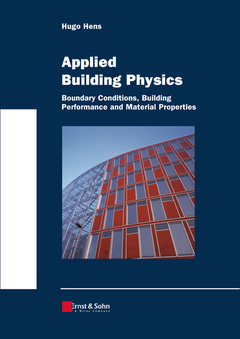Applied building physics: boundary conditions, building performance and material properties (paperback)
Auteur : HENS Hugo S. L.

0 Introduction.
0.1 Subject of the book.
0.2 Building Physics and Applied Building Physics.
0.3 Units and symbols.
0.4 References.
1 Outdoor and Indoor Conditions.
1.1 Overview.
1.2 Outdoor Conditions.
1.2.1 Dry bulb (or air) temperature.
1.2.2 Solar radiation.
1.2.3 Long wave radiation.
1.2.4 Relative humidity and (partial water) vapor pressure.
1.2.5 Wind.
1.2.6 Precipitation and wind-driven rain.
1.2.7 Standardized outside climate values.
1.3 Indoor conditions.
1.3.1 Dry bulb (or air) temperature.
1.3.2 Relative humidity and (partial water) vapor pressure.
1.3.3 Water vapor release indoors.
1.3.4 Indoor climate classes.
1.3.5 Indoor/outdoor air pressure differentials.
References.
2 Performance Metrics and Arrays.
2.1 Definitions.
2.2 Functional demands.
2.3 Performance requirements.
2.4 Some history.
2.5 Performance arrays.
2.5.1 Overview.
2.5.2 In detail.
2.6 References.
3 Functional Requirements and Performances at the Building Level.
3.1 Thermal comfort.
3.1.1 In general.
3.1.2 Physiological basis.
3.1.3 Global steady state thermal comfort.
3.1.4 Local discomfort.
3.1.5 Transient conditions.
3.1.6 Comfort-related enclosure performance.
3.2 Health and indoor environmental quality.
3.2.1 In general.
3.2.2 Health.
3.2.3 Definitions.
3.2.4 Relation between pollution outdoors and indoors.
3.2.5 Physical, chemical and biological contaminants.
3.2.6 Bio-germs.
3.2.7 Human related contaminants.
3.2.8 Perceived indoor air quality.
3.2.9 Sick building syndrome.
3.2.10 Contaminant control by ventilation.
3.2.11 Ventilation requirements.
3.3 Energy efficiency.
3.3.1 In general.
3.3.2 Some statistics.
3.3.3 End energy use in buildings.
3.3.4 Space heating.
3.3.5 Parameters defining the net energy demand for heating in residential buildings.
3.3.6 Parameters defining the net energy demand for cooling in residential buildings.
3.3.7 Gross energy demand, end energy use.
3.3.8 Residential buildings ranked in terms of energy efficiency.
3.4 Durability.
3.4.1 In general.
3.4.2 Loads.
3.4.3 Damage patterns.
3.5 Life cycle costs.
3.5.1 In general.
3.5.2 Total and net life cycle cost.
3.5.3 Examples.
3.6 Sustainability.
3.6.1 In general.
3.6.2 Life cycle analysis.
3.6.3 High performance buildings.
3.7 References.
4 Heat-Air-Moisture Performances at the Envelope Level.
4.1 Introduction.
4.2 Air-tightness.
4.2.1 Flow patterns.
4.2.2 Performance requirements.
4.3 Thermal transmittance (U).
4.3.1 Definitions.
4.3.2 Basis for performance requirements.
4.3.3 Examples of performance requirements.
4.4 Transient thermal response.
4.4.1 Properties of importance.
4.4.2 Performance requirements.
4.4.3 Consequences for the building fabric.
4.5 Moisture tolerance.
4.5.1 In general.
4.5.2 Built-in moisture.
4.5.3 Rain and rain penetration.
4.5.4 Rising damp.
4.5.5 Water heads.
4.5.6 Hygroscopic moisture.
4.5.7 Surface condensation.
4.5.8 Interstitial condensation.
4.5.9 All sources combined.
4.6 Thermal...
Date de parution : 05-2010
Ouvrage de 288 p.
24x17 cm
Disponible chez l'éditeur (délai d'approvisionnement : 12 jours).
Prix indicatif 69,88 €
Ajouter au panier


